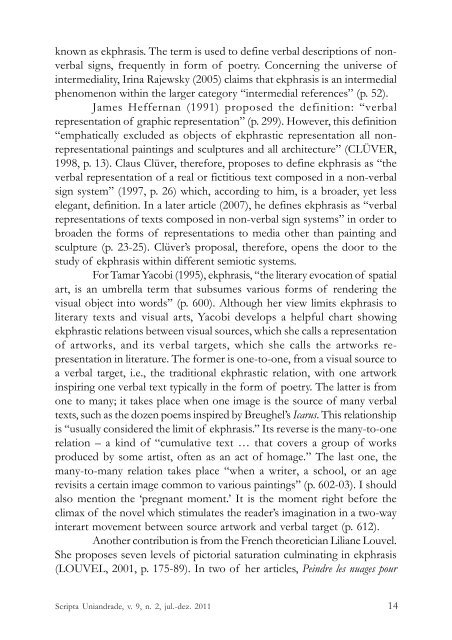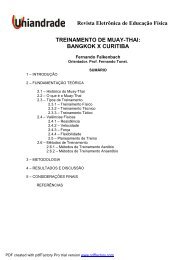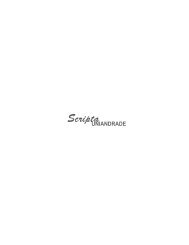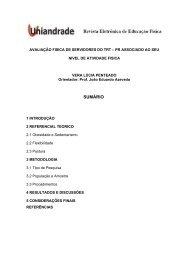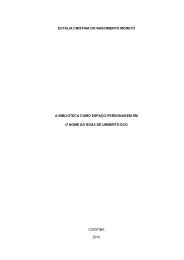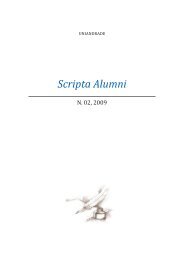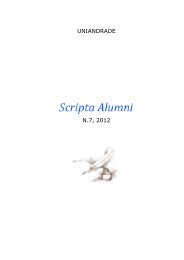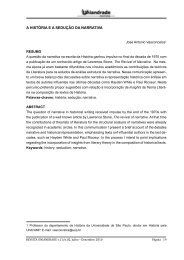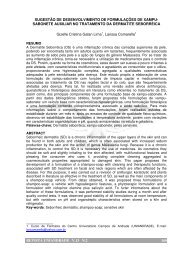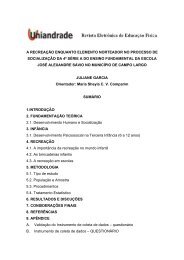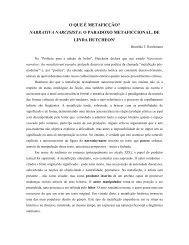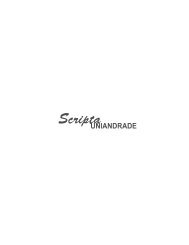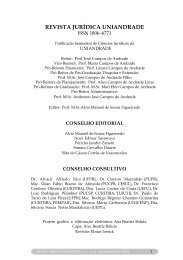Scripta 9_2_link_final.pdf - Uniandrade
Scripta 9_2_link_final.pdf - Uniandrade
Scripta 9_2_link_final.pdf - Uniandrade
Create successful ePaper yourself
Turn your PDF publications into a flip-book with our unique Google optimized e-Paper software.
known as ekphrasis. The term is used to define verbal descriptions of nonverbal<br />
signs, frequently in form of poetry. Concerning the universe of<br />
intermediality, Irina Rajewsky (2005) claims that ekphrasis is an intermedial<br />
phenomenon within the larger category “intermedial references” (p. 52).<br />
James Heffernan (1991) proposed the definition: “verbal<br />
representation of graphic representation” (p. 299). However, this definition<br />
“emphatically excluded as objects of ekphrastic representation all nonrepresentational<br />
paintings and sculptures and all architecture” (CLÜVER,<br />
1998, p. 13). Claus Clüver, therefore, proposes to define ekphrasis as “the<br />
verbal representation of a real or fictitious text composed in a non-verbal<br />
sign system” (1997, p. 26) which, according to him, is a broader, yet less<br />
elegant, definition. In a later article (2007), he defines ekphrasis as “verbal<br />
representations of texts composed in non-verbal sign systems” in order to<br />
broaden the forms of representations to media other than painting and<br />
sculpture (p. 23-25). Clüver’s proposal, therefore, opens the door to the<br />
study of ekphrasis within different semiotic systems.<br />
For Tamar Yacobi (1995), ekphrasis, “the literary evocation of spatial<br />
art, is an umbrella term that subsumes various forms of rendering the<br />
visual object into words” (p. 600). Although her view limits ekphrasis to<br />
literary texts and visual arts, Yacobi develops a helpful chart showing<br />
ekphrastic relations between visual sources, which she calls a representation<br />
of artworks, and its verbal targets, which she calls the artworks representation<br />
in literature. The former is one-to-one, from a visual source to<br />
a verbal target, i.e., the traditional ekphrastic relation, with one artwork<br />
inspiring one verbal text typically in the form of poetry. The latter is from<br />
one to many; it takes place when one image is the source of many verbal<br />
texts, such as the dozen poems inspired by Breughel’s Icarus. This relationship<br />
is “usually considered the limit of ekphrasis.” Its reverse is the many-to-one<br />
relation – a kind of “cumulative text … that covers a group of works<br />
produced by some artist, often as an act of homage.” The last one, the<br />
many-to-many relation takes place “when a writer, a school, or an age<br />
revisits a certain image common to various paintings” (p. 602-03). I should<br />
also mention the ‘pregnant moment.’ It is the moment right before the<br />
climax of the novel which stimulates the reader’s imagination in a two-way<br />
interart movement between source artwork and verbal target (p. 612).<br />
Another contribution is from the French theoretician Liliane Louvel.<br />
She proposes seven levels of pictorial saturation culminating in ekphrasis<br />
(LOUVEL, 2001, p. 175-89). In two of her articles, Peindre les nuages pour<br />
<strong>Scripta</strong> <strong>Uniandrade</strong>, v. 9, n. 2, jul.-dez. 2011<br />
14


